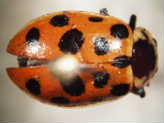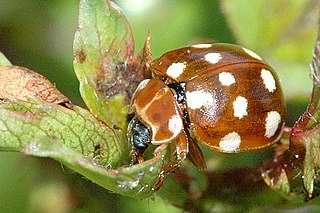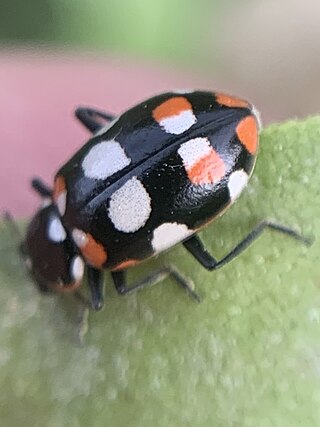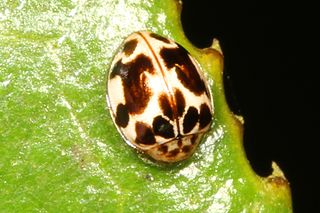
Biological control or biocontrol is a method of controlling pests, whether pest animals such as insects and mites, weeds, or pathogens affecting animals or plants by using other organisms. It relies on predation, parasitism, herbivory, or other natural mechanisms, but typically also involves an active human management role. It can be an important component of integrated pest management (IPM) programs.

Hippodamia tredecimpunctata, commonly known as the thirteen-spot ladybeetle, is a species of lady beetle.
Coccinella novemnotata, the nine-spotted ladybug or nine-spotted lady beetle or C9, is a species of ladybug in the family Coccinellidae native to North America. This beetle was once ubiquitous across the continent but experienced a sharp and drastic decline around the 1960’s. Now, considered a rare species, the nine-spotted ladybug has received much attention from researchers who wish to understand the causes of its decline and restore the population of this charismatic beetle to benefit from their aphidophagous nature as biocontrol agents in agriculture.

Coccinella septempunctata, the seven-spot ladybird, is a carnivorous beetle native to the Old World and is the most common ladybird in Europe. The beetle is also found in North America, Central and Eastern Asia and regions with a temperate climate. Its elytra are of a red colour, but each punctuated with three black spots, with one further spot being spread over the junction of the two, making a total of seven spots, from which the species derives both its common and scientific names.

Hippodamia is a genus of ladybirds in the family Coccinellidae. It includes the most common native North American "ladybug", H. convergens, which can form overwintering aggregations numbering in the millions. Another notable member is Hippodamia variegata, which occurs widely over both the North and South Hemispheres.

Coccinellidae is a widespread family of small beetles. They are commonly known as ladybugs in North America and ladybirds in the United Kingdom; "lady" refers to mother Mary. Entomologists use the names ladybird beetles or lady beetles to avoid confusion with true bugs. The more than 6,000 described species have a global distribution and are found in a variety of habitats. They are oval beetles with a domed back and flat underside. Many of the species have conspicuous aposematic (warning) colours and patterns, such as red with black spots, that warn potential predators that they taste bad.

The soybean aphid is an insect pest of soybean that is exotic to North America. The soybean aphid is native to Asia. It has been described as a common pest of soybeans in China and as an occasional pest of soybeans in Indonesia, Japan, Korea, Malaysia, the Philippines, and Thailand. The soybean aphid was first documented in North America in Wisconsin in July 2000. Ragsdale et al. (2004) noted that the soybean aphid probably arrived in North America earlier than 2000, but remained undetected for a period of time. Venette and Ragsdale (2004) suggested that Japan probably served as the point of origin for the soybean aphid's North American invasion. By 2003, the soybean aphid had been documented in Delaware, Georgia, Illinois, Indiana, Iowa, Kansas, Kentucky, Michigan, Minnesota, Mississippi, Missouri, Nebraska, New York, North Dakota, Ohio, Pennsylvania, South Dakota, Virginia, West Virginia, and Wisconsin. Together, these states accounted for 89% of the 63,600,000 acres (257,000 km2) of soybean planted in the United States in 2007.

Coccinella undecimpunctata, the eleven-spot ladybird or eleven-spotted lady beetle, it is native to central Asia, though commonly found in Europe, and formerly North America as its populations are decreasing. It is of the family Coccinellidae, commonly referred to as ladybugs or lady beetles.

Cryptolaemus montrouzieri, common name mealybug ladybird or mealybug destroyer, is a species of ladybird beetle native to eastern Australia. The beetle feeds on mealybugs and other scale insects, and is used to control those pests on citrus orchards worldwide.

Calvia quatuordecimguttata, the cream-spot ladybird, is a species of ladybird in the family Coccinellidae. Its distribution is holarctic, it being found in Europe and through the East Palearctic to Japan. It is introduced to North America. This ladybird is generally 4 to 5 millimetres in length and varies in appearance depending on the geographical location. It usually lives in hedgerows and deciduous trees.

Coleomegilla maculata, commonly known as the spotted lady beetle, pink spotted lady beetle or twelve-spotted lady beetle, is a large coccinellid beetle native to North America. The adults and larvae feed primarily on aphids and the species has been used as a biological control agent. Based on name connotation and to avoid confusion with other species also called "spotted ladybeetle", spotted pink ladybeetle is probably the most appropriate common name for this species.

Cycloneda sanguinea, also known as the spotless lady beetle, is a widespread species of ladybird beetle in the Americas.

Anatis ocellata, commonly known as the eyed ladybug, is a species of ladybug in the family Coccinellidae. It has black spots on a red background, with each spot surrounded by a yellowish halo. In one color variation, a specimen found in Scotland was reported having the spots fused to form longitudinal lines. Sometimes can also be found variation where black spots are absent.

Eriopis connexa is a species of ladybird beetle that is native to South America. Both males and females mate multiple times with different individuals of the opposite sex, like most members of the family Coccinellidae. This promiscuous behavior leads to unique reproductive adaptations, such as sperm mixing. Females lay unfertilized eggs which their offspring consume upon hatching, thereby boosting offspring nutrition and reducing sibling cannibalism,. This predatory beetle species feeds primarily on aphids and is widespread throughout many agroecosystems, such as cotton, maize, sorghum, soybean, and wheat. Due to aphids being extremely damaging agricultural pests, E. connexa has been introduced to the United States for biological pest management. Recent studies on pyrethroid insecticide resistance in E. connexa have led to research by applied entomologists on the species' potential role in integrated pest management schemes in crop fields that rely on lambda-cyhalothrin (LCT), a common pyrethroid insecticide that is ineffective against aphid population control. The potential efficacy and success of the utilization of E. connexa in these programs is widely debated and is the focus of much recent research due to the lack of understanding regarding the effects of pyrethroid resistance on the behavior of this species.

Olla v-nigrum is a species in the family Coccinellidae, in the suborder Polyphaga. The species is known generally as the ashy gray lady beetle. The distribution range of Olla v-nigrum includes Central America, North America, and Oceania. It is usually gray or pale tan with small black spots on its elytra and thorax. However, a variation can resemble Chilocorus orbus, another species of lady beetle. This form is black with two red spots on the wing covers and has white on the edge of the prothorax.

Laricobius nigrinus is a species of tooth-necked fungus beetle in the family Derodontidae. It is native to western North America, and it is being studied as a biological control agent for the hemlock woolly adelgid. It was first released in 2003 and continues to be reared and released across the Northeast to control infestations.
Cryptognatha nodiceps, known generally as the coconut scale predator or sugarcane scale predator, is a species of lady beetle in the family Coccinellidae; it is found in the Caribbean region, North America, and Oceania, having been introduced to various countries in an attempt to provide biological pest control of the coconut scale.

Psyllobora vigintimaculata, the twenty-spotted lady beetle, is a species of lady beetle in the family Coccinellidae. It is found in North America.
Propylea dissecta, is a species of lady beetle native to India, Sri Lanka, Bangladesh and Nepal.

Aleochara bilineata is a species of rove beetle that lives in sub-tropical and cold tolerant climates throughout the world. This beetle was first biologically described by Wadsworth in 1915. It is used by humans as crop pest control due to the variety of pests it consumes, including caterpillars, mealybugs, mites, maggots. These beetles have a larval phase that occurs over the winter and an adult phase that emerges in the spring. They are often found in moist environments, in compost, or near crops.


















